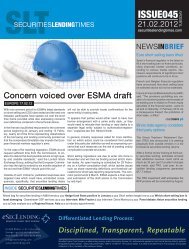PanelDiscussioncollateral requirements is the first step towardsoptimisation. With this combined picture, firmswill be better able to determine the ‘best’ wayto meet collateral demands. <strong>Collateral</strong> optimisationis not necessarily only about finding andselecting collateral at the lowest cost. It can alsoinclude many other criteria when selecting theassets to use. With the right optimisation enginein place, firms should be better placed for selectingthe optimal collateral to use, regardlessof the amounts involved.Baauw: We see alot of demand fortools on top ofall of the tripartyagents and theirexisting tradingsystemsLeveroni: <strong>Collateral</strong> inventory will become oneof the major challenges in the post Dodd-Frankand the European Market Infrastructure Regulation(EMIR) world. High quality collateral will beavailable, but it will come at a price. The ability tooptimise a manager’s existing collateral pool willbecome a must. But, that only goes so far. Manyfirms that face a shortage of high quality collateralwill need to evaluate the collateral needs ofthe transactions before the trade is executed, aswell as conduct a cost benefit analysis to determinethose transactions that are worth the costof collateral and those that are not. The vastmajority of market participants are not doing thistoday, but will need to in the future.How is technological innovationshaping collateral management?Rivett: Traditionally, the industry found itselfchallenged to replace legacy systems, given thecomplexity involved. However, increasing clientdemand is forcing a need for change, as clientsneed to support their businesses with more sophisticatedtools such as eligibility testing, multilayerconcentration limits and substitutions, aswell as global availability and 24-hour access tosystems. Technological innovation has helped.IT systems are increasingly component-built, allowingfunctionality to be leveraged—once developed—acrossdifferent business lines. Thisoffers clear cost advantages.Equally important are the changes in the consumerindustry, which have led to increasingdemand for better user experience. Clients arelooking for more personalised reporting, or eventhe ability to have mobile access to data. <strong>Collateral</strong>management services are not isolated fromsuch trends in technological innovation.Baauw: I think that this is topic number one for allof the system vendors and consultants based onthe requirements their clients have these days.They have been working on system configurationssince the day people began realising thecost variation of different kinds of collateral assetclasses is not something temporary and the businesshas been changed forever. At Synechron,we see a lot of demand for tools on top of allof the triparty agents and their existing tradingsystems, for optimising the collateral flows viaalgorithms. You can only achieve this by havingdetailed static data with a dynamic collateral costprice attached for every asset class. The result isthat your entire trading book could be optimisedthanks to collateral cost transparency. Besidesthis, your profit and loss reporting will be moredetailed and transparent as well, and you will beable to run scenario simulations on your portfolio.Harland: Technological innovation has alwaysshaped collateral management. As we all beginto seek greater efficiencies and risk mitigation,continued advances will be necessary in orderto meet the latest market requirements.A technology driven firm, BNY Mellon continuouslydevelops its collateral engine around rulesetimplementation, market pricing data feeds,and haircut computation. We also modify ourproprietary technology for triparty and applythese changes to connect clearing brokers andCCPs for the allocation and reporting of noncashcollateral. In the future, technological innovationfor both new and established vendor systemson the market will be of critical importance.We use a vendor solution as part of our Derivatives360outsourcing service, and the vendor’sregular updates allow us to be ready to serviceour clients post-Dodd-Frank/EMIR.In summary, technology plays a pivotal role whenprocessing and optimising collateral, especiallywhen meeting the vast number of collateral obligationsthat are required by central clearing.Awan: Efficient collateral management solutionsare essential to enable market participantsto tackle the many operational complexities theyface when managing collateral for multiple purposesin different locations. The ability to valueand deliver multiple asset types as collateralwhile taking into consideration the different operationalpractices across various market segmentsand counterparties requires technologicalinnovation.The growing need for high-quality collateral inher-28ent to new regulatory regimes will force collateralresource accessibility on a much broader scalethan today. Technology will need to be adapted tomeet such huge scale and speed requirements.Technology will also need to support greater interoperabilitybetween market infrastructures atall levels of the post-trade processing chain.Newman: Technology is essential when youare looking to optimise collateral usage—it isnot something that you can do by hand for anythingmore than a few positions. This involvesdata capture, transformation and managementas a starting point and then a sophisticatedoptimisation engine to sit on top. <strong>Collateral</strong> allocationproblems tend to involve non-linearanalysis, which can be fairly compute intensive,so a fast and scalable engine is key. Technologyis also automating collateral optimisation,which can result in large numbers of collateralmovements and substitutions. Finally, thereis the distribution of management information.The collateral process can produce a lot ofdetailed information, and providing intelligentsummary information that enables managers totake actions helps cut through the noise and letspeople understand the key aspects of their operation:where is the concentration risk? Wheredoes the process break down? How efficient ismy allocation algorithm? This holistic view ofenterprise collateral management is made possibleby technology.Tomkinson: The complexities of collateral managementsolutions are highly technical, so technicalinnovation is fundamental to shaping thechanges underway in collateral management.The need to work at an enterprise level with asingle consolidated collateral pool across numerousproduct silos has challenged the marketsfor some time. Recent technological focushas generated solutions to realise this vision—albeit at different levels of sophistication, asindividual firms identify and address their ownspecific business needs.It is possible to identify three key stages in the collateralmanagement evolutionary process of mostfirms. The first stage simply addresses data integrityand ensures that data is captured in an accurate,timely and usable form. Good examples are thecodification of legal documents into operationallyreadable form and consolidating settlement datafrom different sources. The second stage involvesmaximising the data integration processes—improvingoperational efficiency and processes. Thethird stage, which is currently the focus of a numberof the more sophisticated firms, provides the realvalue-add processing, often driven by the overridingneed to minimise balance sheet utilisation thatresults from collateral optimisation algorithms andsophisticated operational practices such as monitoringthe opportunity cost of collateral.www.securitieslendingtimes.com
PanelDiscussionNeri: Technology is helping collateral managers toautomate manually intensive operational processes,and improving the flow of data on exposuresand collateralisation throughout the organisation.This is allowing more time to focus on strategic decisionmaking about asset allocation and liquidity.Technology is also driving cutting-edge optimisationtechniques that are rapidly becoming a necessityfor balance sheet management in the newregulatory environment. Optimisation is helpingfirms make better use of valuable collateral andenabling a smoother transition to the regulatorycapital requirements that are laid out in Basel III.Once the migration of standardised bilateralderivatives contracts to CCPs is fully underway,technology will also help collateral managers tomake best execution decisions based on eachCCPs margining criteria and netting capabilities.Finally, collateral management systems willallow users to forecast exposure scenarios andresulting margin requirements through the lifecycleof a given trade more accurately. They canthen price this into the cost of collateral calculationand predicted profit and loss at the start ofthe trade, and make more informed decisionson which trades will be most profitable.Lillystone: Firms can now handle hundreds if notthousands of active agreements across multiplebusiness lines at once, automatically generatingand publishing margin call information, performingdaily reconciliations of portfolios, accessing globalinventories, which are often distributed disparately,and helping to negotiate and settle collateralwithin ever tighter deadlines. This would not havebeen possible without the application of technologyand technological innovation.In these times of heightened awareness of visibleand hidden risks, collateral managers need tokeep all their interested parties, both internal andexternal, integral to and informed of current andpotential situations on an almost continuous basis.It is in this area where collateral management isharnessing new technologies, such as throughthe use web-based tools, new data-miningtechniques, and advanced data visualisationsolutions. These extend the reach of collateralmanagement within firms to offer counterpartyfacinginterfaces that draw the margining partiescloser than ever, to deliver user-definablereporting, and also to offer self-service collateralmanagement portals.them to rely on portals to handle interactionswith customers and custodians, such as enablingcustomers to choose eligible collateralfrom that available in the portfolio to satisfy anegotiated margin call, and for custodians to bemade immediately aware of the agreement betweenthe collateralising parties.Communication between parties and custodiansis now migrating from the flimsy, insecuretelephone/email paradigm for negotiating margincalls, reconciliations and collateral transfers,to one founded on resilient, fault-tolerant, guaranteed-deliveryelectronic messaging. Whilethis has long been discussed, it is finally butslowly coming to market.Leveroni: Technology is the foundation for almosteverything that we have discussed. Managinga daily collateral management process,thriving in a mixed cleared / non-cleared environment,and facilitating collateral optimisation all requirean automated, efficient technical solution. Ifa firm wants to truly manage their counterpartyrisk, spreadsheets and manual processes arejust not good enough anymore. The requiredcollateral calls are too frequent, collateral eligibilityhas become too complex, and the overallcollateral will be in short supply. Simply put, technologyallows us to eliminate the potential for arepeat of past mistakes, while well preparing usto capitalise on future opportunities.MacAllan: To an extent, technological capabilityhas always shaped collateral management. Manyof the standard practices that we see in the markettoday have been defined by early technology solutionsand the extents or limits of their capacities.More so than ever, firms are looking to technologyto provide the tools with which to meetthe current challenges of the collateral market,across products. Frequently, in all but the largestfirms, internal change and technology teamsdo not have the capacity to support change ata sufficient rate to meet all emerging requirementsin this space, and so are looking to thirdpartyvendors to provide solutions.Technology vendors see the current environmentas a double-edged sword—it is a rapidlychanging environment that presents a challenge,as today’s solution may not be fit forpurpose for tomorrow’s as-yet-unknown requirements.However, it also presents a goldenopportunity to innovate and design configurableand flexible tools that can be adapted to theshifting demands of the market.At Lombard Risk, our COLLINE strategy is toprovide a truly cross-product margin platform,with optional and configurable functionality to allowcross-product netting, for both bilateral andcleared markets, and collateral optimisation. SLTSelf-service portals enable collateral managers,whether service-providers or not, to deliverfundamental as well as advanced features andfunctions to others, both inside and outside ofthe organisation. <strong>Collateral</strong> management nowhas practical tools and solutions that enable29www.securitieslendingtimes.com












